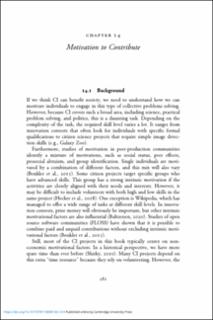| dc.contributor.author | Baltzersen, Rolf K. | |
| dc.date.accessioned | 2022-09-25T23:48:42Z | |
| dc.date.available | 2022-09-25T23:48:42Z | |
| dc.date.issued | 2022 | |
| dc.identifier.uri | https://hdl.handle.net/11250/3021120 | |
| dc.description | Chapter 14 in Cultural-historical perspectives on collective intelligence
In the era of digital communication, collective problem solving is increasingly important. Large groups can now resolve issues together in completely different ways, which has transformed the arts, sciences, business, education, technology, and medicine. Collective intelligence is something we share with animals and is different from machine learning and artificial intelligence. To design and utilize human collective intelligence, we must understand how its problem-solving mechanisms work. From democracy in ancient Athens, through the invention of the printing press, to COVID-19, this book analyzes how humans developed the ability to find solutions together. This wide-ranging, thought-provoking book is a game-changer for those working strategically with collective problem solving within organizations and using a variety of innovative methods. It sheds light on how humans work effectively alongside machines to confront challenges that are more urgent than what humanity has faced before. This title is also available as Open Access on Cambridge Core. | en_US |
| dc.description.abstract | Chapter 14 explores what motivates individuals to contribute to CI projects. If we think CI can benefit society, we need to understand what motivates individuals to engage in collective problems solving. However, both the complexity of the tasks and the required skill levels varies a lot. It ranges from innovation contests that often look for individuals with specific formal qualifications to citizen science project that require simple image detection skills. In a historical perspective, we have more spare time than ever before and many CI-projects depend on this extra “time resource”. However, the competition is fierce with social media and other entertainment services. The chapter examines a wide range of motivational factors, such as being immersed, being recognized, being part of a community, learning as motivation, economic motivation and making societal contributions. Statements from top solvers in online innovation contests comprise an important part of the content in this chapter. | en_US |
| dc.language.iso | eng | en_US |
| dc.rights | Attribution-NonCommercial-NoDerivatives 4.0 Internasjonal | * |
| dc.rights.uri | http://creativecommons.org/licenses/by-nc-nd/4.0/deed.no | * |
| dc.subject | Being immersed | en_US |
| dc.subject | Being recognized | en_US |
| dc.subject | Peer recognition | en_US |
| dc.subject | Author recognition | en_US |
| dc.subject | Being part of a community | en_US |
| dc.subject | Learning as motivation | en_US |
| dc.subject | Individual learning as motivation | en_US |
| dc.subject | Collective learning as motivation | en_US |
| dc.subject | Transformative learning as motivation | en_US |
| dc.subject | Economic motivation | en_US |
| dc.subject | Making societal contributions | en_US |
| dc.subject | Collective intelligence | en_US |
| dc.title | Motivation to Contribute | en_US |
| dc.type | Chapter | en_US |
| dc.description.version | publishedVersion | en_US |
| dc.rights.holder | Rolf K. Baltzersen | en_US |
| dc.source.pagenumber | pp 381-398 | en_US |
| dc.identifier.doi | 10.1017/9781108981361.014 | |

